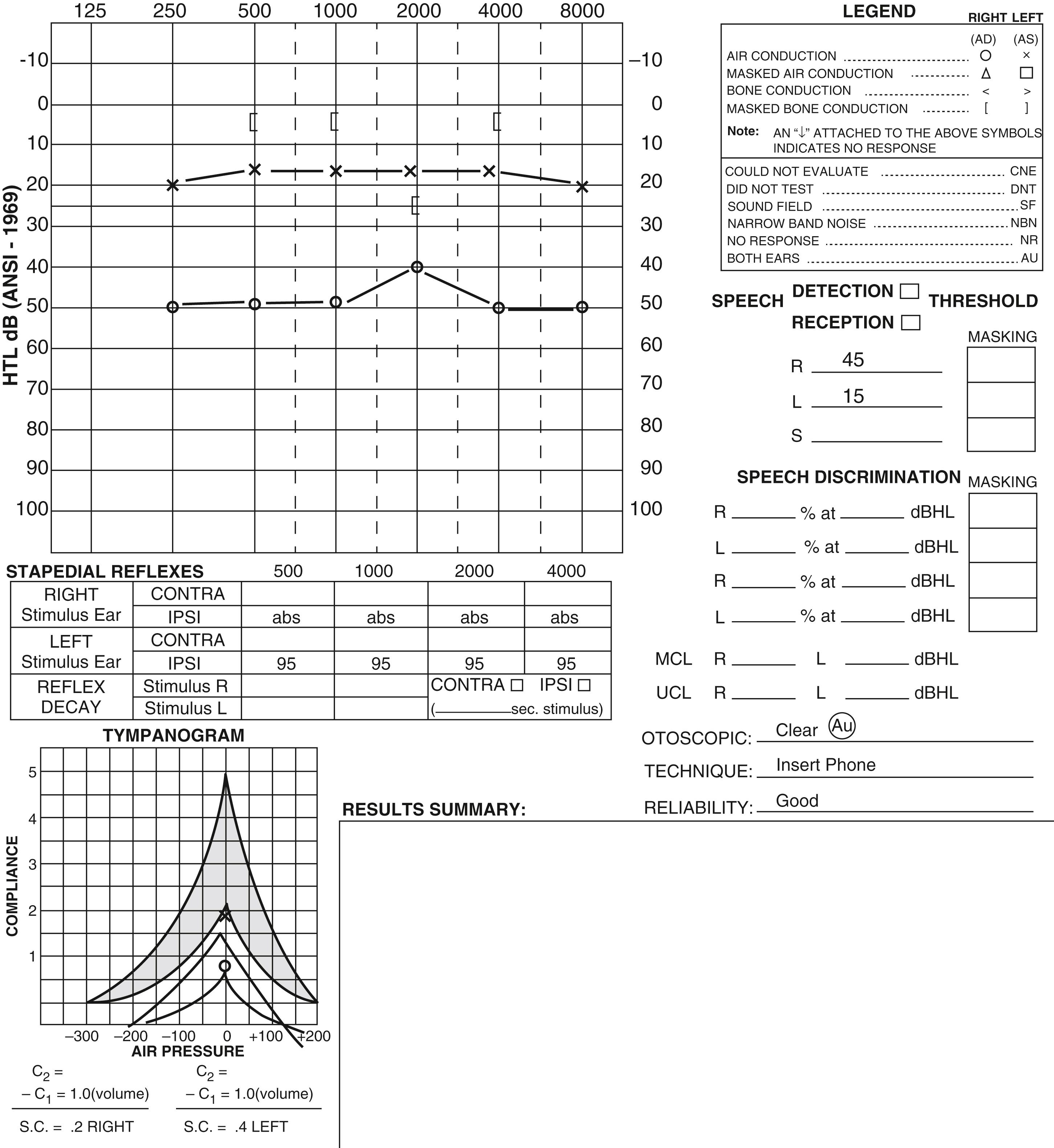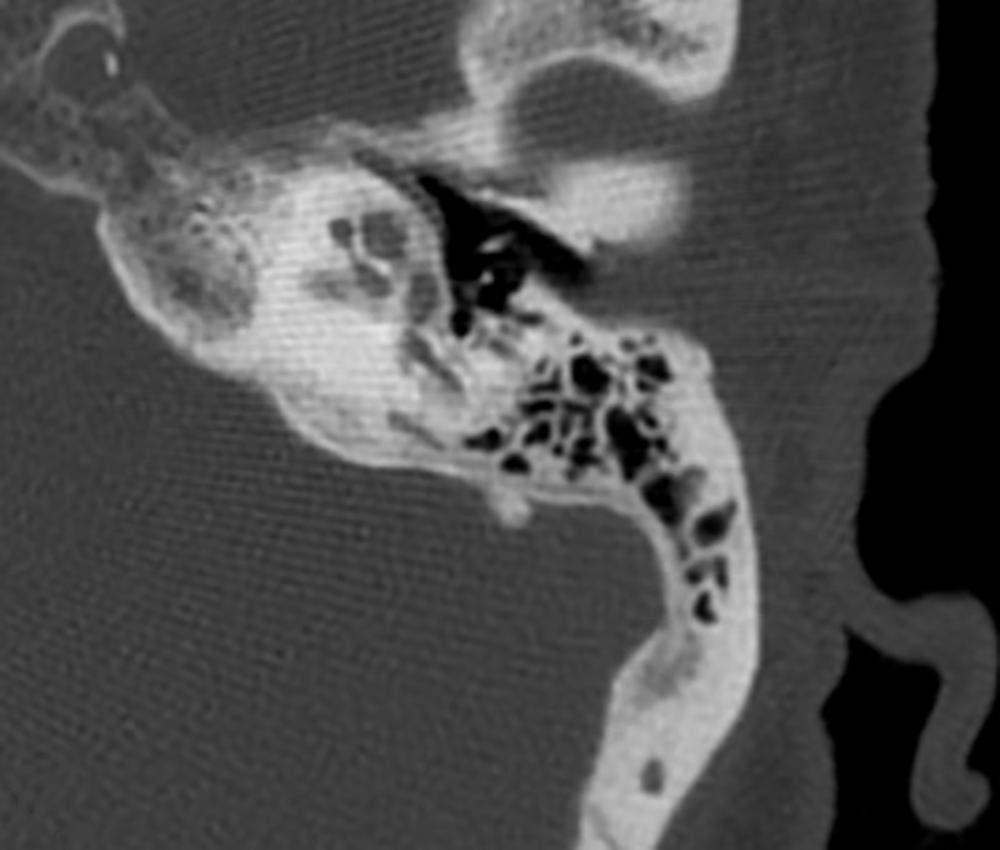Physical Address
304 North Cardinal St.
Dorchester Center, MA 02124
Otosclerosis is a disease of the otic capsule characterized by both resorption and bony deposition with associated neovascularization. This abnormal bony growth of the otic capsule will eventually result in fixation of the ossicles, frequently at the stapes footplate or the incudostapedial joint. The disease was first identified by Valsalva in 1704 and later termed otosclerosis by Politzer in 1894. Histologically the sclerotic foci appear as dense mineralized bone or well-vascularized bone that appears spongiotic. The characteristic blue mantles of Manasse represent the most recently remodeled bone.
Most cases of otosclerosis appear to be familial, inherited in an autosomal dominant fashion with variable penetrance, and are more common in females (frequently reported as a 2:1 ratio). The mean prevalence is 0.2% to 0.4%, with a mean presentation in the third decade of life. Several polymorphisms in the COL1A1, BMP2, BMP4, TGFB1, and RELN genes have been associated with sporadic otosclerosis. Altered expression of the bone specific osteoprotegerin is believed to play an inflammatory role in otosclerotic foci. There have been multiple studies finding immunohistochemical evidence of virus-induced inflammation in temporal bones with otosclerosis suggesting a role in pathogenesis. Hormonal changes have also been implicated, as is seen in the development of clinical otosclerosis during pregnancy. Despite these findings, the overall pathophysiology of otosclerosis remains unclear and is likely multifactorial.
The vast majority of patients with otosclerosis are Caucasian and of European descent. Recent studies have found an increasing incidence (perhaps due to increase in diagnosis) of otosclerosis in both Japanese and Chinese patients though the disease process seems milder in these populations. Autopsy dissections of temporal bones demonstrate histologic evidence of otosclerosis 10 times more frequently than clinical otosclerosis, suggesting a certain amount of otosclerosis is tolerated without symptomatic correlation. This may help elucidate the increase in diagnosis in other races and ethnicities, as well as explain their lack of clinical presentation. Case reports of presentation in other races have been published, although the incidence remains low for these populations.
The surgical treatment of otosclerosis involves bypass of the fixed stapes footplate. This may be accomplished via stapedotomy or stapedectomy. As laser and microdrills have been introduced, the precision of stapes surgery has improved, and surgeons have largely adopted stapedotomy as the standard of care.
Good outcomes for this surgery have been well documented. The guidelines of the Committee on Hearing and Equilibrium recommend an air-bone gap closure of less than 10 dB as an effective measure of success of surgical intervention. Several systematic reviews have demonstrated the safety and efficacy of laser-assisted stapedotomy, resulting in improved visualization due to bloodless intraoperative view, less risk of mobilization of the footplate, and avoidance of inner ear injury.
Preoperative counseling is essential, particularly in cases with mixed hearing loss.
Optimize a bloodless field with a good local injection and topical epinephrine, if needed.
Presence of stapedial reflexes should lead one to consider superior semicircular canal dehiscence (SCCD).
Adequate surgical exposure is key for safety and efficiency.
Separation of the incudostapedial joint should be performed in the posterior to anterior direction to take advantage of the countertraction provided by the stapedius tendon.
Avoid suctioning over the stapedotomy.
History of present illness
Conductive hearing loss: Clinical otosclerosis arises from the bony deposition causing ossicular fixation typically resulting in unilateral or bilateral conductive hearing loss. Mixed and purely sensorineural hearing loss (resulting from cochlear otosclerosis) may also be present, though these presentations are rare. Tinnitus may be associated with hearing loss.
Patients typically present in their third decade, though this may range from patients in their teens to those in their sixties.
Hearing loss is inevitably progressive, given continued bone resorption and deposition.
Past medical history
Assess for history of vertigo, particularly symptoms suggestive of Meniere disease or SCCD. The Tullio phenomenon, vertigo induced by loud noises, may suggest SCCD.
Anesthesia risk factors: Cardiopulmonary disease, renal or liver failure
Alcohol dependence or substance abuse
Past surgical history
Previous ear surgery. Previous stapes surgery increases risk of poor hearing outcomes and vertigo.
Family history
Family members with middle-age onset hearing loss or having had surgery for hearing loss
Medications
Anticoagulation—Surgeons should reinforce the discontinuation of medications that inhibit coagulation approximately 7 days prior to surgery.
Seasonal allergies—Optimize medications and timing of surgery.
Psychosocial consideration
Ability to comprehend an informed consent
Employment—Particularly if the patient’s job involves frequent flying or heavy lifting, make plans for restrictions in the postoperative period.
Typically the examination of the ear is normal. Bilateral otomicroscopy should be performed on all patients with suspected otosclerosis. Confirmation of normal external auditory canals and healthy appearing tympanic membranes should be performed. This helps distinguish any other external or middle ear pathology as sources for possible conductive hearing loss.
Schwartz sign: Occasionally, slight redness may be seen behind the tympanic membrane due to the increased vascularity over the promontory during active remodeling or otospongiosis.
Tuning fork examination is also critical. Classic findings for conductive hearing loss using 256 and 512 Hz tuning forks involve a negative Rinne in which bone conduction is greater than air conduction (classically termed “flipped forks”) and a Weber examination that lateralizes to the affected ear (if one ear has greater conductive loss than the other). These findings suggest that at least a 15 dB air-bone gap will exist on formal audiometric testing.
Conductive hearing loss—An air-bone gap of at least 20 dB should be appreciated prior to offering surgery. Hearing loss less than this should prompt nonoperative management and re-evaluation at a later date.
Carhart notch—An audiologic finding consisting of a discreet decrease in bone conduction at 2000 Hz thought to result from loss of the resonant frequency of the ossicular chain. Other conditions such as middle ear effusion and primary malleus fixation may lead to similar findings, and thus Carhart notch is suggestive but not pathognomonic of otosclerosis ( Fig. 133.1 ).

Stapedial reflexes—In cases of early otosclerosis, the stapedial reflexes may still be intact. However, the presence of preserved stapedial reflexes should lead one to consider alternate diagnoses such as superior canal dehiscence, where conductive loss can also be present due to a “third window” effect.
Imaging is not necessary for routine conductive hearing loss.
A CT scan is indicated if conductive hearing loss with intact reflexes is present to rule out SCCD.
CT scan findings in otosclerosis may include a lucency of the otic capsule near the oval or round window, resulting from demineralization during the active otospongiosis phase. Extensive cochlear demineralization may result in the double ring or halo sign. A mixed loss is often present ( Fig. 133.2 ).

MRI with gadolinium may enhance active foci of otospongiosis.
Become a Clinical Tree membership for Full access and enjoy Unlimited articles
If you are a member. Log in here